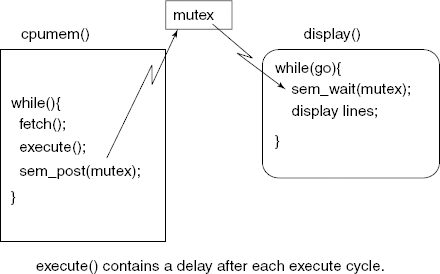2.3 A Virtual Machine for Simple
The virtual machine VM1, given in C source code vml. c, executes a code given in VM1 “assembly” language form. It has a live display, which shows contents of all the machine registers and some portion of the memory, for execution of each instruction. It uses POSIX threads and ncurses, a CRT text screen handling package, which optimizes the operations for repeated updates. See Fig.2.4 for a typical display.
VM1 Machine Simulator
IP: 10000 IR: ef000000 A: 2345 M : 0 BP: 0 SP: 2345
500000a 501000c 54e0001 600000d 506000d ef000000 0 0
0 0 2345 1234 a 2345 0 0
0 0 0 0 0 0 0 0
0 0 0 0 0 0 0 0
0 0 0 0 0 0 0 0
0 0 0 0 0 0 0 0
0 0 0 0 0 0 0 0
0 0 0 0 0 0 0 0
0 0 0 0 0 0 0 0
0 0 0 0 0 0 0 0
0 0 0 0 0 0 0 0
0 0 0 0 0 0 0 0
0 0 0 0 0 0 0 0
0 0 0 0 0 0 0 0
0 0 0 0 0 0 0 0
0 0 0 0 0 0 0 0
Output: 4 IX1: a
IX2: 0
IX3: 0
Fig.2.4 Typical display provided by VM1 simulator
The structure and the machine code for VM1 were already described in Section 2.1.2. The source code for the simulator, vml.c, is available elsewhere. The structure of the simulator is shown in Fig.2.5 .
The following are the major functions in the simulator:
fetch( ) get the next instruction from the memory as per IP.
operand( ) get the operand (and its address) specified in the instruction fetched.
execute( ) execute the instruction just fetched with the operand obtained, then sleep for a couple of seconds.
load( ) used in the main( ) to load the machine code from a file.
display( ) display registers and memory contents and wait till execute ( ) is ready for the next display. This will be a few seconds before the next instruction.
The simulator reads in the program file, having one line per instruction and six fields containing hexadecimal values, separated by blank/s, as shown below:
<load addrss> <OP> <M> <RP> <R> <ADDRS>
and then immediately starts “executing” the program. The display changes dynamically as various values are put in the machine registers.
For our example program, the content of the machine program file is:
0100 15 0 0 0 000A
0101 06 0 0 0 0110
0102 06 0 0 0 0000
0103 05 0 0 0 0110
0104 12 0 0 0 1
0105 0A 0 0 0 FFFB
0106 FF 0 0 0 0100
0110 0 0 0 0 0
This is what an “experienced machine language programmer” would write. Compare it with the output code of the compiler.

